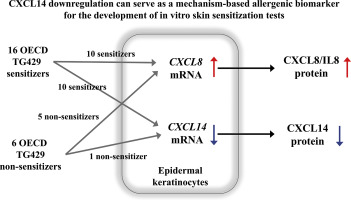当前位置:
X-MOL 学术
›
Toxicol. Appl. Pharmacol.
›
论文详情
Our official English website, www.x-mol.net, welcomes your
feedback! (Note: you will need to create a separate account there.)
CXCL14 downregulation in human keratinocytes is a potential biomarker for a novel in vitro skin sensitization test.
Toxicology and Applied Pharmacology ( IF 3.3 ) Pub Date : 2019-11-14 , DOI: 10.1016/j.taap.2019.114828 Eunyoung Lee 1 , Sungjin Ahn 1 , Sun Hee Jin 1 , Moonyoung Lee 1 , Jeong Joo Pyo 1 , Jeayoung C Shin 1 , Seungchan An 1 , Jaehyoun Ha 2 , Minsoo Noh 1
Toxicology and Applied Pharmacology ( IF 3.3 ) Pub Date : 2019-11-14 , DOI: 10.1016/j.taap.2019.114828 Eunyoung Lee 1 , Sungjin Ahn 1 , Sun Hee Jin 1 , Moonyoung Lee 1 , Jeong Joo Pyo 1 , Jeayoung C Shin 1 , Seungchan An 1 , Jaehyoun Ha 2 , Minsoo Noh 1
Affiliation

|
To elucidate the roles of epidermal keratinocytes in the toxicological outcomes of chemically induced contact dermatitis, genome-scale transcriptional analyses were performed using normal human keratinocytes (NHKCs) treated with 10 μM sodium lauryl sulfate (SLS) or 5 μM urushiol. In Gene Ontology (GO) enrichment analyses, SLS- and urushiol-induced upregulated DEGs are commonly associated with the regulation of pro-inflammatory responses and epidermal differentiation processes in NHKCs whereas cellular protein metabolic process was also identified as a commonly downregulated DEG signature. Among the downregulated DEGs, CXCL14 was investigated as a potential biomarker for a new in vitro skin sensitization test using OECD TG429 reference chemicals. CXCL14 was significantly downregulated in NHKCs in response to 62.5% of the OECD TG429 sensitizers in a concentration-dependent manner. When the sensitizer-induced upregulation of chemokine CXCL8 was included in the analysis, 87.5% of the OECD TG429 reference sensitizing chemicals significantly induced either CXCL8 upregulation or CXCL14 downregulation in NHKCs. Only one OECD TG429 reference non-sensitizer changed the constitutive CXCL14 expression in NHKCs whereas five out of six non-sensitizers altered CXCL8 production. The reference irritating non-sensitizer SLS caused a false-positive outcome. The downregulation of constitutively expressed CXCL14 was regulated by both the MAPK/ERK and JAK3/STAT6 pathways in NHKCs. CXCL14 can be used as a mechanism-based biomarker in the development of in vitro skin sensitization tests and may help improve the distinction between allergenic sensitizers and non-sensitizers.
中文翻译:

CXCL14在人类角质形成细胞中的下调是一种新型的体外皮肤致敏试验的潜在生物标志物。
为了阐明表皮角质形成细胞在化学诱导的接触性皮炎的毒理学结果中的作用,使用正常人角质形成细胞(NHKC)进行了基因组规模的转录分析,其中,正常人角质形成细胞经过10μM月桂基硫酸钠(SLS)或5μMurushiol处理。在基因本体论(GO)富集分析中,SLS和尿嘧啶诱导的DEGs通常与NHKC中促炎反应和表皮分化过程的调节相关,而细胞蛋白代谢过程也被认为是DEG信号通常下调的标志。在被下调的DEG中,使用OECD TG429参考化学品对CXCL14进行了一项潜在的生物标志物研究,用于一项新的体外皮肤敏化试验。NHKC中的CXCL14显着下调至62。5%的OECD TG429敏化剂浓度依赖性。当将敏化剂诱导的趋化因子CXCL8上调包括在分析中时,87.5%的OECD TG429参考致敏化学品在NHKC中显着诱导CXCL8上调或CXCL14下调。只有一种OECD TG429参考非敏化剂改变了NHKC中的本构CXCL14表达,而六种非敏化剂中的五种改变了CXCL8的产生。参比刺激性非敏化剂SLS导致假阳性结果。在NHKC中,组成型表达的CXCL14的下调受MAPK / ERK和JAK3 / STAT6途径的调节。CXCL14可用作体外皮肤敏化试验开发中的一种基于机制的生物标志物,并且可以帮助改善过敏性敏化剂和非敏化剂之间的区别。
更新日期:2019-11-14
中文翻译:

CXCL14在人类角质形成细胞中的下调是一种新型的体外皮肤致敏试验的潜在生物标志物。
为了阐明表皮角质形成细胞在化学诱导的接触性皮炎的毒理学结果中的作用,使用正常人角质形成细胞(NHKC)进行了基因组规模的转录分析,其中,正常人角质形成细胞经过10μM月桂基硫酸钠(SLS)或5μMurushiol处理。在基因本体论(GO)富集分析中,SLS和尿嘧啶诱导的DEGs通常与NHKC中促炎反应和表皮分化过程的调节相关,而细胞蛋白代谢过程也被认为是DEG信号通常下调的标志。在被下调的DEG中,使用OECD TG429参考化学品对CXCL14进行了一项潜在的生物标志物研究,用于一项新的体外皮肤敏化试验。NHKC中的CXCL14显着下调至62。5%的OECD TG429敏化剂浓度依赖性。当将敏化剂诱导的趋化因子CXCL8上调包括在分析中时,87.5%的OECD TG429参考致敏化学品在NHKC中显着诱导CXCL8上调或CXCL14下调。只有一种OECD TG429参考非敏化剂改变了NHKC中的本构CXCL14表达,而六种非敏化剂中的五种改变了CXCL8的产生。参比刺激性非敏化剂SLS导致假阳性结果。在NHKC中,组成型表达的CXCL14的下调受MAPK / ERK和JAK3 / STAT6途径的调节。CXCL14可用作体外皮肤敏化试验开发中的一种基于机制的生物标志物,并且可以帮助改善过敏性敏化剂和非敏化剂之间的区别。











































 京公网安备 11010802027423号
京公网安备 11010802027423号